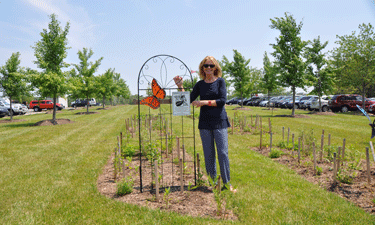 It’s hard to believe that the monarch butterfly may soon be a distant memory. That’s right, if the monarch’s rate of decline continues your grandchild or even your children may never see a live monarch. But we don’t have to let this happen — in fact, we can play a major role in saving the monarch. And when we endeavor to save this beautiful creature from extinction, we will also show the world what we are capable of when we act upon a shared vision.
It’s hard to believe that the monarch butterfly may soon be a distant memory. That’s right, if the monarch’s rate of decline continues your grandchild or even your children may never see a live monarch. But we don’t have to let this happen — in fact, we can play a major role in saving the monarch. And when we endeavor to save this beautiful creature from extinction, we will also show the world what we are capable of when we act upon a shared vision.
There are many great things that NRPA members do collectively for conservation, such as our dedication to getting 10 Million Kids Outdoors and the commitment we all share to raise the next generation of stewards for our parks, but it is very rare that all of us can work together to help save a wildlife species that is in serious trouble. So how do we, as a field, help save the monarch? As caretakers of parks, we are in a unique position to restore monarch habitat by planting milkweed gardens and larger restoration areas on our lands and at our facilities. While there are many factors contributing to the demise of the monarch, the loss of the milkweed is by far the most critical, because the monarch’s survival essentially depends on the milkweed plant.
NRPA is working with a number of organizations and potential funders to provide milkweed plants and materials for agencies to plant to help restore habitat for monarchs. You will see more information on this in the very near future. Milkweed gardens are inexpensive to plant and very easy to maintain. In fact, the staff at NRPA worked with a local Eagle Scout candidate to plant our monarch waystation in front of the NRPA headquarters building in Ashburn, Virginia. You can read more about our efforts in NRPA Vice President of Conservation and Parks, Rich Dolesh’s piece, “Parks Saving the Monarch,” on page 54.
While we have chosen to focus on the monarch, the truth is that we are in danger of losing many other pollinator species, as well. Using connected park lands as wildlife corridors is a real solution to saving many threatened and endangered species and saving the monarch is just the beginning. The public is beginning to appreciate the value of open space and the critical need it fills beyond recreation.
I hope your agency will join the fight to save the monarch. And, just as important, work with us to demonstrate the power of parks and recreation to the public.
We can make a difference, and our impact can be extraordinary if we join together.
Barbara Tulipane, CAE, is NRPA's President and CEO.

